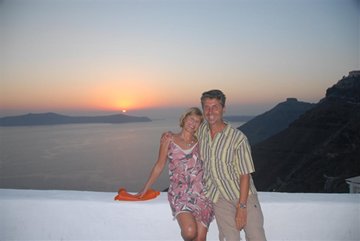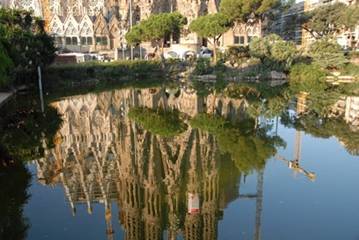Sailing and us

|
12 September 2010 “41:22.73N
2:11.10E”
This blog was established to document our
trip across the Atlantic Ocean between I recall the warm summer night, the
dreamy walk on the Chain Bridge in Do you do any sport? His body language changed, his eyes lit up and without delay came the unexpected answer. “I sail! “ In the mind of any self-respecting female, sailing was associated with Gin &Tonic, romantic sunsets and gentle breeze. So not very tactfully I declared. “Sailing is not a sport!” And so my 35 year association with
sailing was sealed. Steve married me because my sanding was not only done with
enthusiasm but it was faultless. I like to think that other qualities also
contributed. Our relationship survived double-handed dinghy sailing and replica
keel boat racing on Then, due to some lucky circumstances, in
1985 we moved to The Viking 30s are legendary in The little known Royal Perth Yacht Club
became the challenger and for the next couple of years Fremantle became the
centre of the yachting world. In a typical understated We raced three pretty hopeless seasons at
the Royal Perth Yacht Club on the At the end of the 90s we also started
bare boat chartering on the In 2002 we chartered on Palma de
Mallorca. As we walked out from the marina for a late dinner I spotted a
brokerage that was still open. With not too many customers around we received an
enthusiastic demonstration of all available yachts. We did not like any of them
and feeling a little embarrassed about taking so much time of the salesman I
offered an excuse and blurted out that “We would need a blue water yacht that is
capable of sailing back to ” Oh, why didn’t you say so? - exclaimed the agent. And he pulled out a file from which a
Hallber Rassy 42, graceful, like a queen, gently smiled at us. It was a love at
the first sight! Without thinking we changed our plans, sailed the chartered
boat to The last trip of my dying father was to
our new yacht, Fenix, in the summer of 2003. Since then we used our leaves to
criss-cross the Mediterranean from We have been contemplating an Atlantic crossing for years and I was delighted when Steve after his birthday in January announced that the “The Year of the Tiger” has become the “The Year of the Crossing”! So, we spent most of the year enthusiastically preparing ourselves and the boat. Here we are, a little anxious but full of anticipation! THE BOAT - FENIX II (Hallberg Rassy HR42E)
Fenix has been lucky to have had only two very caring previous owners who were found of her and looked after her needs with great attention. Everyone knows that you get attached to your boat. So much so, that the first owner, who in a moment of absent-mindedness sold her to us, after 5 years of trying different vessels decided to buy another Hallberg Rassy 42E. He just could not forget her graceful move and her spacious, comfortable interior. In an unexpected twist of events he bought it from one of our friends. The previous owner of Fenix installed a new 106HP Volvo, extended her stern with a sugar scoop creating a comfortable landing and swimming platform and installed a massive davit for easy deployment of our RIB dinghy, so handy when visiting those picturesque Mediterranean towns. Upon taking ownership Steve embarked on a seemingly never ending process of further upgrades, including the removal of the aft head and using the extra space to create a glamorous owner’s cabin complete with a desk and armchair, modernizing the saloon, adding an “invisible” crane to lift on and off our scooter (great to get to know places), a custom made SS navigation display for the cockpit, a new anchor that never drags (Rocna), a “fully tamed” one-touch electrical toilet (you wouldn’t know that you are actually on a boat), modified the stove, developed and installed a water leak alarm, dimmer lights, changed the rigging, equipped her with a second backup autopilot, 3 GPSs, and AIS (sending and receiving), a sea anchor, and even an automatic freshwater shut down system after we lost all our water due to a loose pipe junction. Our lovely large teak deck also received a lot of TLC. In 2009 Steve declared the boat “ready”. This was of course before we decided to participate in the ARC. This decision was not taken lightly and resulted in the frantic upgrade of the sail wardrobe (asymmetrical for light wind, Parasailor2 for “typical” conditions, and poled out headsails sat up as a twizzle rig for strong wind conditions) purchase of a drogue, a manual emergency water maker, DuoGen, securing the drawers and cupboards etc. LIST OF FENIX II UPGRADES and EQUIPEMENT Conversions and additions - Stern converted to sugar scoop - SS davit with radar arch - Scooter stand and fold-out crane for scooter lift - Aft head removed to increase aft cabin, desk with swivel armchair - Folding Perspex shower door, light, mixer tap, sump pump-out - New washbowl and taps - Electrical toilet with one-touch cycling control, bowl emptying system - Modernized saloon with rounded settees, curtains, shelf lids - Shades and fans, hanging fan for aft cabin hatch - Instrument panel at navigation table - Slide-out work bench with vice - New kitchen counter and sink - Easy store washboard - Dodger and bimini with roll-up aft curtain Electrical: - Mastervolt charger and separate inverter - Intelligent alternator controller with dual alternators - Masthead LED light with flash control - 30G/m emergency bilge pump - Microwave - Removable flexible solar panel on top of bimini - 2 Air Conditioners in aft cabin and saloon - Water leak detector pump shut-down - Search light - Dimmer lights - Cockpit dining light - LED reading lamps and desk lamp Instrumentation - Boat navigation PC with screen at navigation table and custom SS cockpit console - Backup chartplotter - Second backup GPS with separate antenna - Raymarine 8002 autopilot, custom SS console at binnacle and backup Autohelm - Navman Depth, Speed, Wind and repeater at Navigation Table - Anchor chain counter - Digital barometer - Barometer / Temperature / Clock - JVC radar on radar arch - AIS Class B Transmit / Receive - VHF radio with two consoles - Satellite Iridium phone - Water ingress alarm with 5 sensors - WIFI antenna - TV antenna - DVD player with Ipod connection in cockpit - TV on custom fold-out arm - Compact portable printer and scanner - Handheld VHF and GPS Equipment - Volvo 106HP diesel engine - In-mast Reckmann hydraulic furler - Reckmann jib furler - Bow thruster - 3.4m RIB with outboard - 33kg Rocna anchor with 100m chain - Danfoss and Fortress anchors - Second bow roller - Bow and stern anchor winches - Sea anchor with 100m 22m nylon rode - Winslow off-shore ISO 6 person life raft in cradle - MOM8 self inflating Dan buoy with light, lifesling and sea anchor - Self inflating lifesling with extra long rope - MOB Scoop - Deck wash - Pony diving tank in holder - cockpit cushions - Folding chairs and custom tray-table New for ARC - Parasailor2 - Asymmetrical 160m2 - 2nd Jib plus fit old jib with hanks along the luff - Second whisker pole and twizzle joint - Folding prop
MaxProp - Jordan series
drogue - Manual large bilge pump inside the saloon - DuoGen towing / wind generator - New E.P.I.R.B GME403G - Spare Wind, Depth and Log instruments - Second Iridium phone +antenna - Emergency VHF antenna - VHF Antenna splitter - Mobilarm 768 personal locator V100 VPIRB - AIS interface to eliminate nuisance alarms when no AIS received - Water maker PUR Survivor 35 - Freshwater flow meter and display - Dinghy Rack to secure dinghy on front deck - Security system - Salt water pressurized for kitchen and head - Sail repair kit, spares, extra tools - Drawer securing webbing and nets for book shelves - Washboards individually secured – barrel bolts - Security foil on dodger glass windscreen - Lee cloths + long cushions + sloped mattress - Seat belt on settees - Cockpit bean bags THE CREW
Steve Rakoczy (skipper) I was about 8 when I first pinched a
dinghy and set out on my own with no sailing skills whatsoever. Luckily the
light breeze and the forgiving nature of the Elizabeth P. Rakoczy I have always had a fascination with
speed and doing things our bodies were not designed for. I cartwheeled,
somersaulted through my childhood to become a competitive gymnast, skied the
slopes of the surrounding mountains and swam the rivers of my hometown. After
meeting my future husband all of these activities were replaced by sailing. In
my 20s I was considered to be a late-comer to the sport but I quickly developed
a love for the excitement of racing and for the tranquillity of cruising. Most
of the time I don’t even mind the technical aspects of the sport. My current
hobby-project is writing about the historical/literary significance of places we
visit during our cruising on the In my normal life I work at the
If the GPS also fails and we have to rely
on my celestial navigation skills we might prove him right and discover that
after all one can sail from
|

 Fenix II is an Enderlein design Hallberg Rassy 42
(extended), 1989 hull number 144, sloop rigged. She is admired for her sheer and
flush teak deck, uninterrupted by raised coach roofs so popular lately. She
looks like a small ship. We like to think of her as a miniature Pinta (one of
the ships
Fenix II is an Enderlein design Hallberg Rassy 42
(extended), 1989 hull number 144, sloop rigged. She is admired for her sheer and
flush teak deck, uninterrupted by raised coach roofs so popular lately. She
looks like a small ship. We like to think of her as a miniature Pinta (one of
the ships 
 There is a tranquil little lake at the Nativity Façade
with an almost Zen Buddhist design, where one can sit down and admire the church
as it is reflected in the soft glassy water of the lake. The inside of the
church is like a walk through a beautiful rain forest packed with trees aiming
for the sunshine. It was really a special morning.
There is a tranquil little lake at the Nativity Façade
with an almost Zen Buddhist design, where one can sit down and admire the church
as it is reflected in the soft glassy water of the lake. The inside of the
church is like a walk through a beautiful rain forest packed with trees aiming
for the sunshine. It was really a special morning.